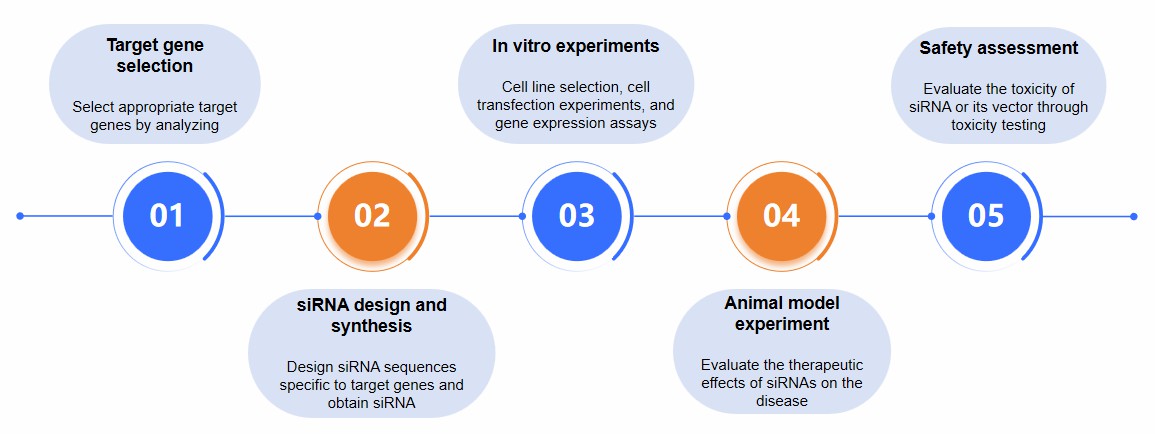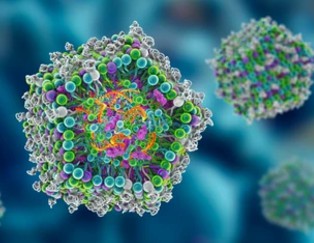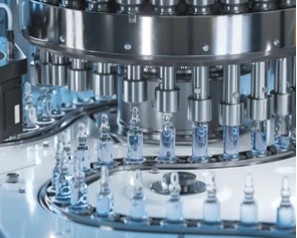RNA Interference Technology
Inquiry
RNA interference technology (RNAi) is the use of double-stranded RNA-induced sequence-specific gene silencing, by regulating and shutting down the expression of genes so that the cell exhibits the phenotype of a specific gene deletion. The expression of specific genes can be specifically deleted or turned off using RNAi technology, so the technology has been widely used in the field of exploring gene function and gene therapy for a variety of diseases. CD Formulation utilizes cutting-edge RNA interference technology to support all phases of gene therapy formulation projects from development to production, and to assist in the research of your project.
Challenges in RNA Interference Technology
Challenges faced by RNA interference technology in practical applications mainly include low transfection efficiency, insufficient specificity, stability and persistence issues, and potential nonspecific effects. The most prominent problem is the efficient transfection of siRNA into cells, especially for primary cells that are difficult to transfect. It is important to note that even a single base mismatch between the siRNA and the target sequence may attenuate the effect of RNAi and may affect the function of other genes that are similar but not identical, increasing the risk of off-targeting. In addition, the issue of siRNA stability and persistence is also a limiting factor, and although chemical modification can improve the stability of siRNAs, it also implies an increase in cost. When RNA interference technology is applied, high concentration and prolonged shRNA expression may lead to cellular damage, which requires us to strictly control the dose of shRNA. We overcome the problems in the practical application of this technology by continuously optimizing and innovating RNA interference technology to maximize the potential of RNAi technology in the field of gene therapy.

Our Novel RNA Interference Technology
Chemically synthesized RNAi services
We can customize our chemical synthesis RNAi services according to customer requirements. From the careful design of double-stranded RNAi constructs to the synthesis of siRNA, we can ensure the highest quality and accuracy. The process extends to transfection into mammalian cells, and ultimately to detection and analysis of inhibition, each stage of which is critical to achieving effective gene silencing.
In the development of gene therapy formulations, customized RNA molecules provide an effective method of silencing specific genes, offering a reliable solution for the development of macro gene therapy formulations.
Vector-mediated RNAi service
Vector-mediated RNAi service involves the embedding of small RNAs, such as short hairpin RNAs (shRNAs), into viral or non-viral vectors to achieve stable, long-term gene silencing. This technology is of even greater importance in gene therapy research where durable suppression of gene expression is required.
Our expertise in the development of a wide range of vectors allows us to offer a variety of technical services, including nanocarrier-mediated RNAi technology, which provides enhanced protection for double-stranded RNAs (dsRNAs), ensures that they remain intact as they enter the target cell, and ultimately improves RNAi efficiency.
Vector-mediated RNAi provides a reliable platform for sustained gene silencing and offers a stable and effective solution for long-term therapeutic programs.
Lentiviral-mediated RNAi service
The use of lentiviral vectors to deliver small RNA molecules directly into host cells ensures long-lasting, stable gene suppression, making it an indispensable part of gene therapy, especially when long-term silencing is required to achieve a therapeutic effect. Lentivirus-mediated RNAi provides a powerful tool for complex diseases that require precise and sustained gene silencing.
Our lentiviral-mediated RNAi service provides a reliable mechanism for achieving durable gene silencing by delivering siRNA directly to the relevant cell type.
Our Workflow of RNA Interference Technology
- Target gene selection. Select appropriate target genes by analyzing the genes related to the disease. And understand the function of target genes and their role in pathology.
- siRNA design and synthesis. This process includes siRNA sequence design. We can help customers design siRNA sequences specific to target genes and obtain siRNA by chemical synthesis or in vitro transcription.
- In vitro experiments. This process includes cell line selection, cell transfection experiments, and gene expression assays.
- Animal model experiment. This process we established animal models to administer siRNAs to animals through appropriate pathways and evaluate the therapeutic effects of siRNAs on the disease.
- Safety assessment. Evaluate the toxicity of siRNA or its vector through toxicity testing to ensure the safety of the host. And use immunogenicity test to detect whether siRNA triggers an immune response.
 Fig.2 Our process of RNA interference. (CD Formulation)
Fig.2 Our process of RNA interference. (CD Formulation)
Our Platforms for RNA Interference Technology
| Our Platforms |
Specifics |
Formulation development platforms
 |
RNA interference technology has been used to specifically target and silence disease-associated genes through designed siRNA molecules, a process with revolutionary potential for areas such as hereditary diseases, viral infections and cancer therapy. We have demonstrated good application potential in the development of gene therapy agents utilizing RNAi technology. |
Drug delivery platforms
 |
The design and use of appropriate siRNA drug delivery systems is important to ensure drug efficacy. Lipid nanoparticle (LNP) technology, as our delivery system, can encapsulate siRNAs to ensure that RNAi drugs can be effectively delivered to the target site, which greatly improves the efficacy and safety of the drugs. |
Quality control platform
 |
Potential safety issues of RNAi drugs, such as intracellular accumulation of siRNA and its metabolites, interference with the endogenous RNAi pathway. Our quality control platform helps to improve the safety of the developed drug formulations. |
Highlights of Our RNA Interference Technology
- Our advanced technology platform allows us to maximize our ability to meet our clients' diverse project needs.
- Innovative R&D concepts ensure that we are always at the forefront of gene therapy formulation development, and that our clients can be confident in working with us.
- A strict quality control system ensures that we provide reliable technical support services to our customers.
- Our experienced team of experts allows us to support our clients in all aspects of their project development.
Explore Our RNA Interference Technology Related Services
Lentiviral Vector Development
The development of lentiviral vectors can efficiently integrate exogenous genes into the genome of host cells and realize long-term stable gene expression, which is now widely used in gene therapy research and other fields and shows a broad application prospect.
Development of Gene Therapy Vectors
A key role in gene therapy research is played by the development of gene therapy vectors, which use certain viral or non-viral vectors to transfer target genes to target cells for the replacement or repair of damaged genes.
Gene Therapy Formulation Development
We rely on advanced vector development technology platforms, drug delivery technology platforms, quality control technology platforms, etc., which can help researchers effectively promote the progress of gene therapy formulation development research.
Published Data
Technology: RNA interference technology
Journal: J Pharmacol Exp Ther
IF: 3.5
Published: 2023
RNA interference technology is a powerful therapeutic strategy and new technologies have been developed to utilize intact cells to generate truly biological RNAi agents that better represent the structure, stability, activity, and safety of natural RNA molecules. In this article, the authors examine the mechanisms of action of endogenous miRNAs and exogenous siRNAs, the physiological and pharmacokinetic barriers to therapeutic RNA delivery, and summarize the chemical modification and delivery platforms being used. The authors also discuss direct expression and stable vector-based in vivo production of novel biological RNAi drugs for research and development.
With an advanced technology platform and an experienced research team, CD Formulation aims to provide comprehensive technical support and reliable solutions for gene therapy formulation development. If you are interested in us, please feel free to contact us.
References
- Traber GM, Yu AM. RNAi-Based Therapeutics and Novel RNA Bioengineering Technologies. J Pharmacol Exp Ther. 2023, 384(1):133-154.
Related Services



 Fig.2 Our process of RNA interference. (CD Formulation)
Fig.2 Our process of RNA interference. (CD Formulation)


